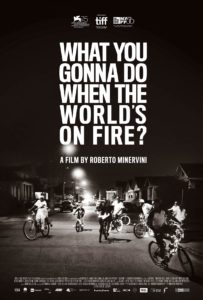Film Review: “What You Gonna Do When the World’s on Fire?” Burns but Doesn’t Consume
Written by: Christopher Llewellyn Reed | August 15th, 2019

What You Gonna Do When the World’s on Fire? (Roberto Minervini, 2018) 3 out of 4 stars.
Italian director Roberto Minervini has, since moving to Texas in 2007, been on a mission to tell elliptical, nuanced stories about both the residents of his new home and those of next-door neighbor Louisiana. Though I missed his “Texas Trilogy” – The Passage (2011), Low Tide (2012) and Stop the Pounding Heart (2013) – in which Minervini combined documentary and fiction techniques, using non-actors but scripting and manipulating parts of their stories, I did catch his 2015 The Other Side, an observational, (ostensibly) nonfiction collaboration between subjects and film crew that followed poor Louisiana whites battling drug addiction and despair, some of them just-returned army veterans unable to adapt well to post-service life. Gripping and disturbing (because of its themes and techniques, simultaneously exploitative and empowering), The Other Side introduced me to a filmmaker from whom I knew I wanted to see more.
And now Minervini is back with a new film – the purest documentary yet – once again set in Louisiana, entitled What You Gonna Do When the World’s on Fire? For the first time, he trains his lens exclusively on African Americans, this time in New Orleans, focusing on four primary subjects: Ronaldo and Titus, young brothers whose father is in prison; Judy, a bar owner and community leader; Krystal, Chair of The New Black Panther Party for Self Defense (NBP), along with her activist colleagues; and Kevin, Big Chief of the Flaming Arrows – a local Native American tribe that, pre-emancipation, harbored escaped slaves and is now a blended mix of ethnicities and cultures – as he prepares for the annual Mardi Gras parade. Cutting back and forth between the threads, Minervini weaves together a solid narrative of longstanding racial grievance and resilience, with protests against the 2016 Baton Rouge police shooting of Alton Sterling much on everyone’s minds (Minervini filmed over the course of 2017). Life goes on, no matter what, however, and the director makes sure to include plenty of positive energy, as well, even in the face of disappointment.

As with The Other Side, access is the key, here, and Minervini has it. Whether plunging us head-first into the boys’ activities as they roam the neighborhood, the meetings in Judy’s bar as she discusses police brutality, the charitable work of the NBP as they donate food to the homeless, and the sewing of beads onto headdresses by Keith and others, the director is present, if uncharacteristically silent and invisible. Indeed, What You Gonna Do When the World’s on Fire? stands as a fine example of cinéma vérité, marking a true departure for Minervini. It is also, however, less formally interesting, as a result. Uncomfortable as I may have been witnessing The Other Side’s troublesome cinematic ethics, I was also thoroughly engaged. Though this new film may be far more respectful of its characters, I admit to my mind occasionally wandering, despite the often absorbing drama on screen. I would have loved a movie about just one of these stories, in greater depth. Since Minervini loves a good trilogy, perhaps his next film can follow the NBP (my favorite part), alone. Burn, baby! Burn!


